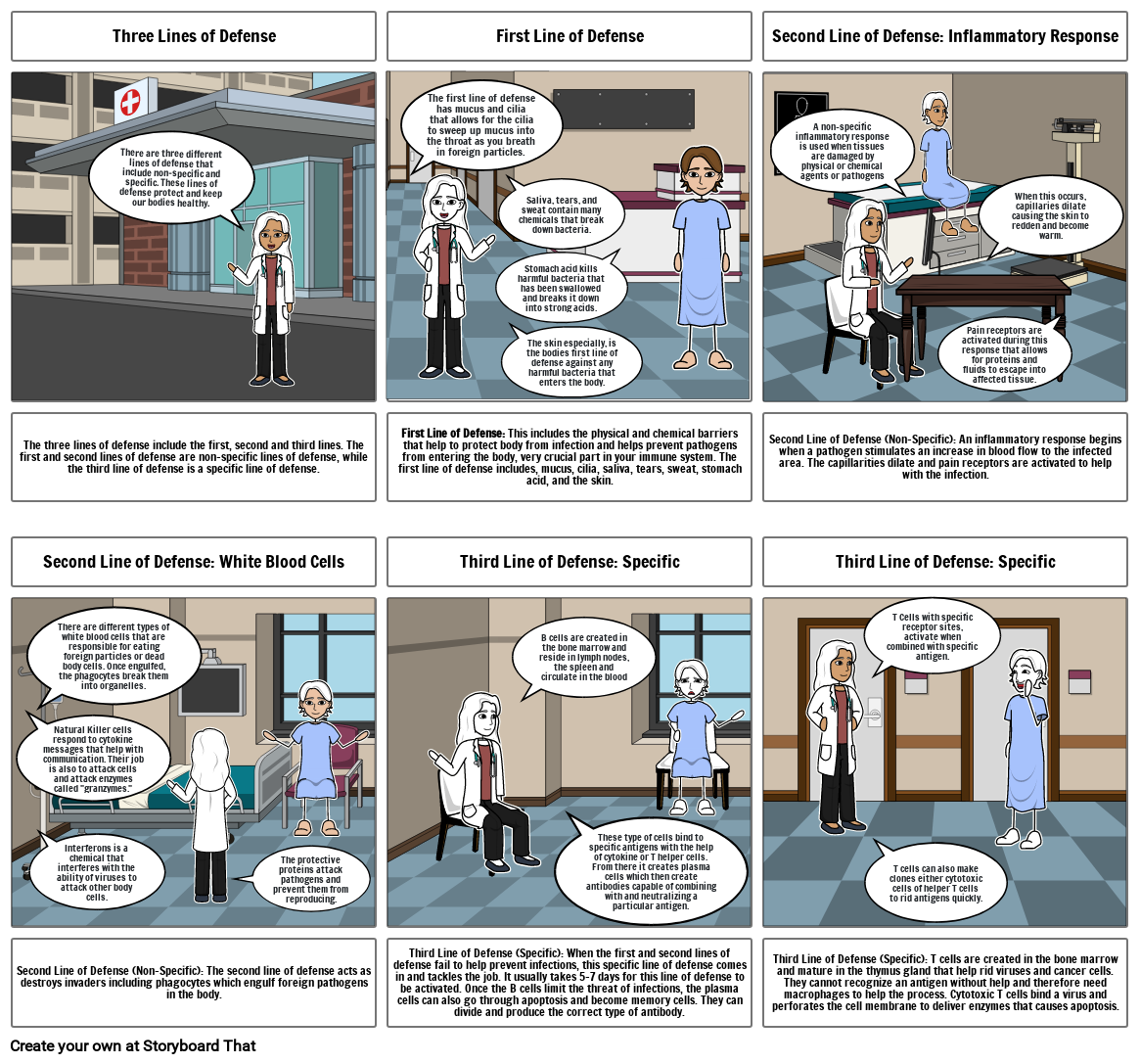Three Line of Defense

Storyboard Text
- Three Lines of Defense
- There are three different lines of defense that include non-specific and specific. These lines of defense protect and keep our bodies healthy.
- First Line of Defense
- The first line of defense has mucus and cilia that allows for the cilia to sweep up mucus into the throat as you breath in foreign particles.
- Stomach acid kills harmful bacteria that has been swallowed and breaks it down into strong acids.
- Saliva, tears, and sweat contain many chemicals that break down bacteria.
- The skin especially, is the bodies first line of defense against any harmful bacteria that enters the body.
- Second Line of Defense: Inflammatory Response
- A non-specific inflammatory response is used when tissues are damaged by physical or chemical agents or pathogens
- Pain receptors are activated during this response that allows for proteins and fluids to escape into affected tissue.
- When this occurs, capillaries dilate causing the skin to redden and become warm.
- The three lines of defense include the first, second and third lines. The first and second lines of defense are non-specific lines of defense, while the third line of defense is a specific line of defense.
- Second Line of Defense: White Blood Cells
- There are different types of white blood cells that are responsible for eating foreign particles or dead body cells. Once engulfed, the phagocytes break them into organelles.
- First Line of Defense: This includes the physical and chemical barriers that help to protect body from infection and helps prevent pathogens from entering the body, very crucial part in your immune system. The first line of defense includes, mucus, cilia, saliva, tears, sweat, stomach acid, and the skin.
- Third Line of Defense: Specific
- B cells are created in the bone marrow and reside in lymph nodes, the spleen and circulate in the blood
- Second Line of Defense (Non-Specific): An inflammatory response begins when a pathogen stimulates an increase in blood flow to the infected area. The capillarities dilate and pain receptors are activated to help with the infection.
- Third Line of Defense: Specific
- T Cells with specific receptor sites, activate when combined with specific antigen.
- Second Line of Defense (Non-Specific): The second line of defense acts as destroys invaders including phagocytes which engulf foreign pathogens in the body.
- Natural Killer cells respond to cytokine messages that help with communication. Their job is also to attack cells and attack enzymes called "granzymes."
- Interferons is a chemical that interferes with the ability of viruses to attack other body cells.
- The protective proteins attack pathogens and prevent them from reproducing.
- Third Line of Defense (Specific): When the first and second lines of defense fail to help prevent infections, this specific line of defense comes in and tackles the job. It usually takes 5-7 days for this line of defense to be activated. Once the B cells limit the threat of infections, the plasma cells can also go through apoptosis and become memory cells. They can divide and produce the correct type of antibody.
- These type of cells bind to specific antigens with the help of cytokine or T helper cells. From there it creates plasma cells which then create antibodies capable of combining with and neutralizing a particular antigen.
- Third Line of Defense (Specific): T cells are created in the bone marrow and mature in the thymus gland that help rid viruses and cancer cells. They cannot recognize an antigen without help and therefore need macrophages to help the process. Cytotoxic T cells bind a virus and perforates the cell membrane to deliver enzymes that causes apoptosis.
- T cells can also make clones either cytotoxic cells of helper T cells to rid antigens quickly.
Over 30 Million Storyboards Created

